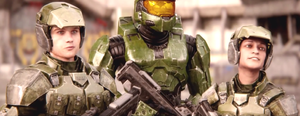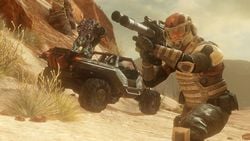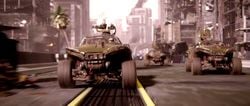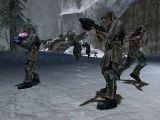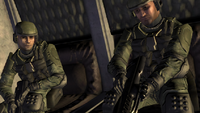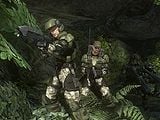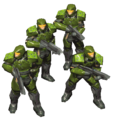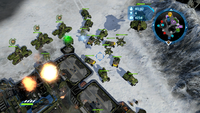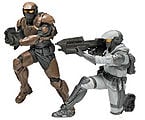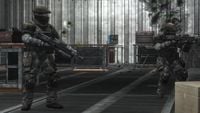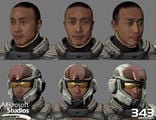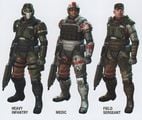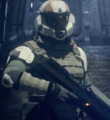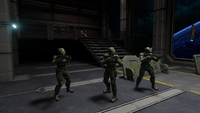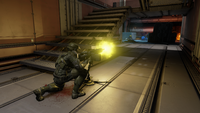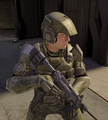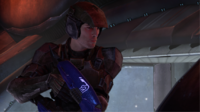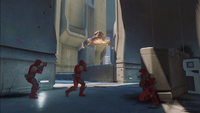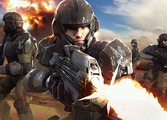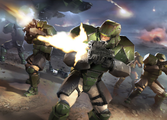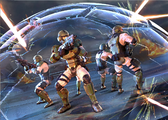UNSC Marine Corps: Difference between revisions
From Halopedia, the Halo wiki
(That assumes those guys are Marines, or UNSC in the first place. Could be Frieden, too. (the others are probably Koslovics, tho)) |
No edit summary |
||
| Line 116: | Line 116: | ||
The Marine Corps' most common aircraft is the [[Pelican]] dropship. The Pelican is used as a multirole aerodyne which is capable of carrying numerous armament configurations, including [[Scorpion missile|Scorpion anti-tank missiles]], [[ANVIL-II Air-to-Surface Missile|Anvil II air-to-surface missiles]], as well as a chin-mounted 7.62mm machine gun, or a 40mm or 70mm autocannon. The Pelican can also be outfitted with an M247 or AIE-486H machine gun in its troop bay. | The Marine Corps' most common aircraft is the [[Pelican]] dropship. The Pelican is used as a multirole aerodyne which is capable of carrying numerous armament configurations, including [[Scorpion missile|Scorpion anti-tank missiles]], [[ANVIL-II Air-to-Surface Missile|Anvil II air-to-surface missiles]], as well as a chin-mounted 7.62mm machine gun, or a 40mm or 70mm autocannon. The Pelican can also be outfitted with an M247 or AIE-486H machine gun in its troop bay. | ||
The UNSC Marine Corps operates the [[GA-TL1 Longsword]] as its primary fighter/interceptor and as a tactical bomber. The Corps also operates the [[Shortsword-class Bomber]], which serves as a close air support aircraft. The Marines utilize the [[AV-14 Hornet]] as a light attack craft and gunship. Earlier in the war, the Marines also utilized the [[AV-22 Sparrowhawk]] as a close air support gunship, though it was largely retired from service due to problems with its propulsion system. Currently, the [[AV-49 Wasp]] supplements the Marine Corps' existing stocks of AV-14 and AV-22 aircraft.<ref>[https://www.halowaypoint.com/en-us/news/canon-fodder-buzz-generating '''Halo Waypoint''': ''Canon Fodder - Buzz Generating'']</ref> Heavy air-to-ground support is provided by the [[AC-220 Vulture]] gunship. Marine air units are usually intended to support ground forces or to drop off vital equipment for the Marines, either in close-air-support or air interdiction roles, with the [[UNSC Navy]] and the [[UNSC Air Force]] taking on the dedicated air force role.<ref>[[Letter - Re:Antilon Mine]]</ref> | The UNSC Marine Corps operates the [[GA-TL1 Longsword]] as its primary fighter/interceptor and as a tactical bomber. The Corps also operates the [[Shortsword-class Bomber]], which serves as a close air support aircraft. The Marines utilize the [[AV-14 Hornet]] as a light attack craft and gunship. Earlier in the war, the Marines also utilized the [[AV-22 Sparrowhawk]] as a close air support gunship, though it was largely retired from service due to problems with its propulsion system. Currently, the [[AV-49 Wasp]] supplements the Marine Corps' existing stocks of AV-14 and AV-22 aircraft.<ref>[https://www.halowaypoint.com/en-us/news/canon-fodder-buzz-generating '''Halo Waypoint''': ''Canon Fodder - Buzz Generating'']</ref> Heavy air-to-ground support is provided by the [[AC-220 Vulture]] gunship. Marine air units are usually intended to support ground forces or to drop off vital equipment for the Marines, either in close-air-support or air interdiction roles, with the [[UNSC Navy]] and the [[UNSC Air Force]] taking on the dedicated air force role.<ref>[[Archive:Letter - Re:Antilon Mine]]</ref> | ||
==Gameplay== | ==Gameplay== | ||
Revision as of 15:02, August 16, 2017
| This article does not meet the wiki's general standards and/or standards on layouts. You can help by cleaning this article. |
| UNSC Marine Corps | |
|---|---|
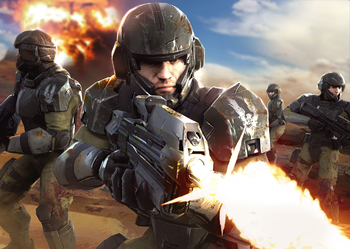
| |
|
Active: |
c. 2163 – present |
|
Affiliation: |
|
|
Branch: |
|
|
Role: |
Expeditionary warfare |
|
Nicknames: |
|
|
Engagements: |
|
|
Commanders: |
|
- "First to Fight."
- — UNSC Marine Corps Credo[4]
The UNSC Marine Corps is a branch of the United Nations Space Command's Armed Forces responsible for conducting land-based expeditionary combat operations, using the mobility provided by the UNSC Navy to rapidly deliver forces. Marines are also charged with the defense of Navy vessels and installations from hostile forces. While structured under the Unified Ground Command,[5] the UNSC Marine Corps operates closely with the UNSC Naval Command and has some authority within the office.[6] The Marine Corps is one of the five branches of the UNSC Armed Forces.[7]
History
Origins and formation
The United States Marine Corps is the precursor to the UNSC Marine Corps.[8] As the Interplanetary War began in the 2160s, the national governments of the Sol system strengthened and deployed their militaries for conflict. However, the distributed nature of their forces led to disorder among the ranks of these militaries. In response, the United Nations organized the United Nations Space Command from Earth's disparate national military forces in 2163;[9] the UNSC Marine Corps was created as one of the UNSC's branches with most of the UNSC consisting of Marine assets, as well as assets of the UNSC Navy.[7] Shortly following the Rainforest Wars, triggered by Koslovic attacks at the Argyre Planitia shipbuilding plants on Mars, the United Nations began the Mars Campaign in December 2163. This campaign marked the first extra-terrestrial deployment of the UNSC Marine Corps, as the UNSC launched a series of lightning strikes against Koslovic forces near the Argyre Planitia.[9]
The decisive success of this campaign had a major impact on future military doctrine, resulting in UNSC Navy warships carrying large Marine contingents for ground assaults and boarding actions. Following the success of the UNSC Marine Corps at Mars, recruitment drives and propaganda tactics strongly bolstered UNSC forces and the Koslovics and Friedens were defeated on Earth in 2170.[10]
The Insurrection

- Main article: Insurrection
From 2494 to 2525, the UNSC Marine Corps would be responsible for dealing with Insurrectionist uprisings on UNSC colonies and star systems. From 2512, the Marines were involved in one of the largest operations in their history, Operation: TREBUCHET, aimed at quelling rebel uprisings in the Eridanus and Epsilon Eridani star systems.
Units from the 9th Marine Expeditionary Force were sent to Eridanus II in force, hoping to capture leaders of the rebel movement and pacify the population. One of these units, the first Battalion of the 21st Marine Division commanded by Lieutenant Colonel Ponder, was involved in a disastrous mission to try and capture the second in command of rebel forces in Elysium City, which ended in the leader's family being killed and Ponder wounded and demoted.[11]
In 2524, a Marine battalion was posted at the colony world of Tribute, commanded by Lieutenant Colonel Aboim and supported by the corvette UNSC Bum Rush, with air support from AV-14 Hornets. The battalion attempted to put a stop to rebel bomb makers near the city of Casbah. Two special warfare squads, led by Staff Sergeants Avery Johnson and Nolan Byrne, were involved in disastrous operation in June. Byrne's team was killed during a hostage situation at a Jim Dandy restaurant near Casbah city; thirty-eight civilians, three Marines, and two rebels were killed in the bombing.[12]
Human-Covenant War
Outer Colony campaigns
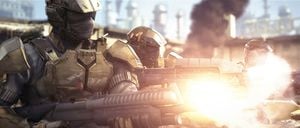
The UNSC Marine Corps' first encounter with the alien Covenant was at the First Battle of Harvest in 2525. At the event, only three Marine officers were present, training the planet's Colonial Militia. During the battle, Captain Ponder became the Corps' first casualty of the war.
Not long after the First Battle of Harvest, the Corps' experienced one of their first major encounters with the Covenant at numerous engagements throughout the Outer Colonies, including the Harvest Campaign, eventually lasting from 2526 to 2531. At the final stages of the campaign, the Marines quickly established a base of operations in Harvest's arctic region. A reconnaissance force led by Sergeant John Forge was deployed to survey the area. However, during the patrol, Covenant forces under the command of Arbiter Ripa 'Moramee overran and nearly destroyed the base. Forge rallied scattered marines, who quickly retook it from the aliens. After receiving reinforcements and repairing the base, the Marines fought through a sizable Covenant garrison force in an attempt to secure a mysterious Forerunner structure in the region.
The Battle of Arcadia saw the UNSC Marine Corps holding the defensive line around major population centers to allow evacuation for the civilian population with the assistance of the SPARTAN-II Red Team. Successfully keeping Covenant forces from occupying the population centers, the Corps' began launching multiple assaults on the Covenant's base of operations to reclaim the planet.
The UNSC Marine Corps would take part in numerous actions against the Covenant on many of the Outer Colonies in the years that followed. Unfortunately, they were hopelessly outgunned, out-numbered and out-flanked by the Covenant forces and the Marine Corps would suffer tremendous losses in what eventually saw the near-destruction of the Outer Colonies.
Siege of the Inner Colonies
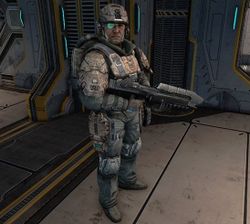
The Corps' experienced another encounter with the Covenant on the colony world of Sigma Octanus IV in 2552. Upon landing, the Marines' hardware and equipments were rendered useless due to the planet's harsh environment. In the first stage of the battle, during a naval engagement, a Covenant DDS-class carrier was able to land a large contingent of troops on the northern pole of the planet. The Covenant were able to take Côte d'Azur, a major population center. Fortunately almost all of the civilian population was evacuated beforehand, but the UNSC Marine Corps' General Kits launched a failed assault to retake the city.
The UNSC Marine Corps maintained a sizable presence on Reach when the Covenant stormed the planet; they bypassed the defense fleet in orbit, as well as the MAC Gun platforms, and made a considerable landing of soldiers on the North and South Poles. During the early hours of the battle, the Covenant had overrun FLEETCOM HQ on Reach, destroying the perimeter and swarming the Marine defenders with Banshees, Wraiths, and battalions of infantry. The situation became severe and critical when the Marines were forced to defend the Orbital Defense Generators against a massive Covenant assault, using every available armored vehicle and defensive position from available bunkers. The Battle of Reach became one of the most devastating defeats for the UNSC Marine Corps in the Human-Covenant War.
The surviving Marines from the Battle of Reach served an important role in the Battle of Installation 04, taking part in such engagements as securing the UNSC Pillar of Autumn crash site, launching multiple guerrilla assaults on Covenant convoys and base of operations and rescuing captured Pillar of Autumn's personnel from a Covenant battlecruiser. Initially, the Marines were part of a special operation consisting of a sizable Orbital Drop Shock Trooper special forces detachment and a standard Marine detachment to infiltrate Covenant High Command and kidnap a Covenant Prophet.
Earth and the end of the war
- "Dear humanity, we regret being alien bastards. We regret coming to Earth. And we most definitely regret that the Corps just blew up our raggedy-ass fleet!"
- — Sergeant Johnson
The UNSC Marine Corps remained in force on Earth and its geosynchronous Orbital Defense Platforms, and were mostly prepared to repulse a relatively small Covenant invasion, when fifteen Covenant capital warships, two Assault Carriers and thirteen Covenant Cruisers, entered the Sol System. They then played a significant role in during the Battle of Earth, where they defended multiple major population centers from the Covenant's occupation such as those in New Mombasa, Cleveland, and Havana.
Several Marine detachments achieved a turning point during the course of the Battle of Earth when they managed to retake the cities and maintain temporary ground control for UNSC reinforcements to arrive. One such Marine detachment was E2-BAG/1/7, which was able to engage the Covenant ground forces in Mombasa, Kenya as the Covenant assault carrier landed ground forces in the city.
The Marine Corps also partook in a major assault alongside the UNSC Navy in the Battle of Voi. As ground forces, the Marines were to engage in the Battle of Voi with a SPARTAN-II supersoldier by eliminating anti-air vehicles and batteries, as well as destroying temporary Covenant outposts to allow UNSC reinforcements to refortify the area.
The Marines fought in the war's last battle at the Ark. Starting with their deployment in an operation codenamed Operation: BLIND FAITH,[13] the Marines launched numerous attacks on Brute strongholds, including an attack on the Ark's cartographer. After fighting on foot, and in heavy vehicles, the Marines drove off the Covenant. They then teamed up with the Elites and attacked three barrier towers protecting the Ark's Citadel. After capturing the first tower, with the help of the Master Chief, Marines and UNSC pilots then defeated the Covenant aerial forces. They then waited for the deactivation of the third tower, where they then staged an attack on the Citadel. After fighting two Scarabs, they were then evacuated back to the fleet while the Master Chief and the Arbiter killed Truth. The surviving Marine forces fell back to Earth through the Portal onboard the Shadow of Intent before Installation 04B was activated.
Further engagements
- Main article: Post-Covenant War conflicts
After the end of the war against the Covenant, the UNSC Marines participated in a number of engagements against the Covenant remnants and the Insurrectionists. Significant numbers of Marines stationed on Draetheus V helped fend off the Covenant assault during the Battle of Draetheus V.[14] A force of Marines were also assigned to the UNSC Navy's new flagship, UNSC Infinity. When the ship subsequently crash-landed on Requiem in 2557, the Marines joined the Spartans in fighting off the opposing Covenant forces and Forerunner Prometheans in the First Battle of Requiem. When Infinity returned to Requiem in order to conquer the planet, Marines were once again dispatched in a joint campaign to reinforce the Spartans. The Second Battle of Requiem, waged in 2558, saw both sides trying to seize the Janus Key before the shield world's destruction.[15]
By 2558, some War Games simulations feature AI Marines that assist the Spartan-IVs in their training.[16]
Organization
The UNSC Marine Corps is one of the five branches of the United Nations Space Command's Armed Forces.[7] The Marine Corps is subordinate to the UNSC High Command and the branch has a seat on the UNSC Security Council, currently represented by General Hogan.[3] The Marine Corps is largely under the authority of the UNSC's Unified Ground Command (UniCom), responsible for managing ground-based operations of the Marine Corps, the UNSC Air Force, and the UNSC Army.[5] However, due to the Marines' expeditionary nature, the branch has some with the UNSC Naval Command, particularly in the Navy-dominated UNSC Fleet Command where the Marines have only a token representation.[6] The branch also maintains its own UNSC Marine Corps of Engineers command.[17] As well as possessing infantry, armored, and air units, the UNSC Marine Corps is based around Marine Expeditionary Forces, which contain at least one division-sized unit of Marines.[18] Because of its role as an "amphibious", space-deployed force, the Marine Corps enjoys a close relationship with the UNSC Navy, with Marine complements being deployed on most warships.[19][20][21] The Marine Corps, along with the Navy, was headquartered at the Fleet Command Headquarters on Reach, until the facility's destruction and the planet's fall in 2552.[22]
In addition to conventional forces, the Marine Corps maintain special operations forces in the form of the Orbital Drop Shock Troopers. ODSTs drop into hostile areas via SOEIVs prior to the main invasion. They attempt to complete some of the most difficult tasks in hostile areas, such as clearing enemy ground forces or establishing landing zones for incoming Pelicans.[23][24]
Personnel
- Main article: UNSC rank structure
Large numbers of men and women are employed by the UNSC Marine Corps. Service people hold ranks, which are divided between officers and enlisted. The rank structure of the UNSC Marine Corps is based around that of the United States Marine Corps.
Uniform
Marine Corps Dress Uniforms are worn on formal or ceremonial occasions, and are similar to those worn by their 20th and 21st Century predecessors in the United States Marine Corps. A variety of dress uniforms exist, including a white-and-blue uniform,[25] an all-blue uniform,[26] and an all-black funerary uniform.[27]
In the field, Marines usually wear passively camouflaged uniforms with usually green M52B body armor. Lightweight, though durable, the armor is surprisingly resilient. Marines don Ushuaia Armory's CH252 helmets equipped with a heads-up display and radio system.[28] These helmets are mounted with recorders[29], and certain models feature holographic text-displaying eyepieces or ballistic goggles. In addition to helmets, Marines on field operations in more humid locales sometimes choose to wear boonie covers, or those in colder environments don visored and thicker helmets. Marine NCOs are easily recognized by the cover they wear complete with the UNSC insignia, although they oftentimes substitute this soft cover for a more practical protective helmet; post-war NCOs often wear a variant with a fully sealed helmet that is otherwise worn by scouts. Marines sometimes don small helmet communications microphones or black-phased sunglasses on their helmets, and others carry backpacks. Marines sometimes wear black gloves to protect their hands and improve their grip on their weapons. Some Marines sport orange visors which attach to the brim of their helmets. Marines operating in cold environments wear environmentally-tailored armor, with insulated snow camouflage utilities and full body armor as well as insulated and visored helmets with something analogous to a balaclava.[30] Marines also wear the lightweight and protective VZG7 armored boots, the standard footwear of the Marine Corps since the middle of the 26th century.[28]
Orbital Drop Shock Troopers sport heavy and articulated black battle armor, which also double as an armored g-suit that allows for safe transport in small ships during turbulent atmospheric entry. They also wear fully-visored, black helmets that cover the entirety of the head, and can withstand several headshots. This armor, overall, provides ODSTs with more protection than standard marine armor.
Equipment
Infantry weapons
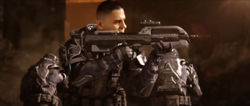
The standard issue weapon for UNSC Marine Corps is Misriah Armory's MA5 assault rifle series, which can be outfitted with an M301 grenade launcher or an underslung shotgun.[31] Marines were issued with the MA5B variant or the MA5C variant, with the former being nearly universally phased out and replaced by the latter in late-2552.[32] After the end of the Human-Covenant War, both previous variants were phased out and replaced by the MA5D. The BR55 battle rifle and its heavy barrelled variant are used both as standard service rifles and as marksman's weapons. Their successor models, the BR85 and BR85HB variants were introduced in the postwar period, with the majority of the Corps favoring the more recent versions as the best models of the battle rifle.[33] Furthermore, the UNSC Marine Corps has adopted the M395 DMR, though previous models have been eclipsed in the Marines by the prominence of the BR55 battle rifle and its variants. The M392 DMR also remains in service with Marine reserve units.[34] The Corps issues several models of the M6 handgun series, with its standard sidearm being the M6H as of 2555, with the improved M6H2 entering service by 2557.[35] Special operations and vehicle crews are issued M7 submachine guns, with ODSTs typically using the suppressed model.[36]
Snipers operate the SRS99C-S2 AM and SRS99D-S2 AM, and more recently the SRS99-S5 AM, sniper rifle variants for anti-matériel and anti-personnel operations.[37] The M99 Special Application Scoped Rifle was also formerly used as a dedicated anti-matériel weapon.[38] Standard UNSC sniper teams consists of two operators; a spotter and a sniper. The M45 and M90 shotguns are often utilized in close-quarters engagements. Once the weapon that defining the Marine Corps as the Unified Earth Government's spaceborne force-in-readiness, the Marine Corps has relegated the shotgun to less-visible duties with boarding parties, though the shotgun still remains an important weapon of close-quarters warfare.[39] The M739 SAW was also adopted in squad-support role.[40]
Anti-armor fire is provided by the M41 "SPNKR" rocket launcher, and more recently the M57 Pilum.[41] The Marines also uses the M6 Spartan Laser, though typically only ODSTs were issued these weapons prior to 2552 due to the high costs of the Spartan Laser at the time.[42] The Marine Corps also utilizes the XM510 grenade launcher.[43] Suppressive fire is provided by the M247 machine gun, the M247H machine gun, the AIE-486H machine gun, and mounted versions of the M41 "Vulcan".[44] The NA4 and M7057 flamethrowers are sometimes used in an anti-infantry role by specialists known as Hellbringers.[45] The M9 fragmentation grenade is the standard-issue hand grenade of the UNSC Marine Corps.[46] Several specialized grenades, as well as numerous types of landmines and explosive charges, are also used by Marine infantry. By 2557, the M363 sticky detonator and ARC-920 railgun have been added to the heavy weapons armory of the UNSC Marine Corps.[47]
Ground vehicles
The Marine Corps makes heavy use of the M12 Force Application Vehicle, which is used for armored patrols, personnel mobility, and combat fire-support. The M12 FAV is produced in several variants. The most common of these variants is the M12 Light Reconnaissance Vehicle, which is armed with an M41 Light Anti-Aircraft Gun, or the later M46 Light Anti-Aircraft Gun. Postwar Marines have begun to utilize the re-armed M12B model of Warthog, equipped with the M343A2 Chaingun. Light anti-vehicle support is provided by the M12G1 Light Anti-Armor Vehicle, armed with either the M68 Gauss Cannon or the more recent M555 Gauss Cannon, the M12A1 Light Anti-Armor Vehicle, which is mounted with a 102mm SC-HE Rocket Turret, and the M12R Light Anti-Armor Vehicle, which features an M79 Multiple Launch Rocket System or updated M80 Multiple Launch Rocket System. The M831 Troop Transport serves as a fast, lightly armored transport vehicle. The M274 Ultra-Light All-Terrain Vehicle is commonly used for scouting and light target interdiction.
For heavy engagements, the Marine Corps operates the older M808B and more recent M808C variants of the M808 "Scorpion" Main Battle Tank, which is armed with an M512 Smooth Bore High Velocity Cannon and a pintle-mounted M247T Medium Machine Gun (M808C) or coaxial M231 Machine Gun (M808B). More recently following the Requiem Conflict, however, the Marine Corps has begun to adopt the updated M820 Scorpion Main Battle Tank, which is armed with the 150mm M990 electrothermal-chemical smoothbore cannon and an as-of-yet unidentified pintle-mounted heavy machine gun. [48] In smaller numbers, the Marines also deployed the heavier dual-M310 smooth-bore high-velocity cannon wielding M850 "Grizzly" Main Battle Tank throughout the Insurrection and Human-Covenant War, but postwar logistical issues led the Marine Corps to retire it.[49] The M9 Wolverine Main Anti-Air Tank (MAAT) is the Corps' primary mobile anti-air asset. The SP42 Cobra Main Battle Tank fills the role of tank destroyer and anti-fortification light artillery support. The M312 Heavy Recovery Vehicle and M313 Heavy Recovery Vehicle provides heavy matériel recovery and troop transport.
Less standard vehicles also saw service with the Marine Corps during the Human-Covenant War. The M-145D Rhino was outfitted with a reverse-engineered plasma mortar. The Gremlin Combat Support Vehicle is used to disable enemy vehicles with its onboard EMP weapon. The Cyclops support exoskeleton was used both repair duties and logistical support, as well as in combat, though it was eventually retired from service. In recent years, the Mantis has been utilized by the Marines, with the Corps having contracted Materials Group to produce a refit package to allow alternate loadouts on the walker.[50]
Aircraft
The Marine Corps' most common aircraft is the Pelican dropship. The Pelican is used as a multirole aerodyne which is capable of carrying numerous armament configurations, including Scorpion anti-tank missiles, Anvil II air-to-surface missiles, as well as a chin-mounted 7.62mm machine gun, or a 40mm or 70mm autocannon. The Pelican can also be outfitted with an M247 or AIE-486H machine gun in its troop bay.
The UNSC Marine Corps operates the GA-TL1 Longsword as its primary fighter/interceptor and as a tactical bomber. The Corps also operates the Shortsword-class Bomber, which serves as a close air support aircraft. The Marines utilize the AV-14 Hornet as a light attack craft and gunship. Earlier in the war, the Marines also utilized the AV-22 Sparrowhawk as a close air support gunship, though it was largely retired from service due to problems with its propulsion system. Currently, the AV-49 Wasp supplements the Marine Corps' existing stocks of AV-14 and AV-22 aircraft.[51] Heavy air-to-ground support is provided by the AC-220 Vulture gunship. Marine air units are usually intended to support ground forces or to drop off vital equipment for the Marines, either in close-air-support or air interdiction roles, with the UNSC Navy and the UNSC Air Force taking on the dedicated air force role.[52]
Gameplay
Halo Wars
Marines are a playable unit in Halo Wars that can be built from a Barracks for 100 resources and one population slot. Armed with MA5B assault rifles and have the ability to throw M9 frag grenades. Marines are a jack of all trades, master of none-type unit typically used to counter aircraft. Marines have the following upgrades:
- New Blood: Adds another Marine to the squad. Costs 200 resources and a tech level of 1.
- RPG: Replaces the M9 frag grenade ability with M41 rocket launchers. Costs 400 resources and a tech level of 2.
- Medic: Adds a Medic to the Marine squad allowing the unit to heal itself after battle. Costs 700 resources and a tech level of 3.
- ODST: Turns all Marines into ODSTs (only available if Captain Cutter is the leader). Armed with M90 shotguns, ODSTs are able to be dropped in from drop pods. Costs 1800 resources and a tech level of 3.
Halo Wars 2
- Info: Core Infantry, Flexible ground troops, Quick capture unit, Effective against air
- Tier: 0
- Cost: Population 3, Supplies 150, Power 0
Marines upgrade: Grenade throw
- Info: New Ability, Can throw grenades, Small Area Attack, Cannot target air
- Tier: 1
- Cost: Supplies 0, Power 400
Marines upgrade: Combat Tech
- Info: Unit Upgrade, Adds Combat Technician, Can repair vehicles, Wields rocket launcher
- Tier: 2
- Cost: Supplies 0, Power 600
Marines can be built by all UNSC leaders at the Firebase. They are a jack-of-all trades unit, performing adequately against infantry, vehicles, aircraft, and structures. Marines can no longer upgraded to ODSTs, who are now a distinct unit.
Trivia

|
See our gameplay information related to UNSC Marine Corps on its gameplay page. |

|
Check out our collection of quotes related to UNSC Marine Corps on its quotes page. |

|
Browse more images in this article's gallery page. |
- The UNSC Marine Corps shares many traits of its culture and organization with the modern United States Marine Corps. Like the USMC, the UNSCMC organizes its units into divisions, which are subdivided into regiments. Most other military forces of the present day are subdivided into brigades. In addition, every known UNSCMC rank corresponds directly to a USMC rank, and the enlisted and officer ranks that have been described imply that the exact same insignia are used as well. Semper Fi, the Latin motto used by the USMC, short for Semper Fidelis ("Always Faithful" or "Forever Faithful") is also used by the UNSCMC.[53] "Ooh Rah", a motivational call originating from the USMC, is often said by Marines of the UNSCMC.
- In the Halo: Combat Evolved level The Truth and Reconciliation, Captain Keyes tells a Marine to "Stow your bellyaching, soldier - remember, you're a leatherneck!" Leatherneck was a nickname earned by US Marines in the era of the Continental Marines. The Marines would wear leather collars to provide protection from slashing attacks as they boarded enemy ships. Although an appropriate reference to Marines, the term "Leatherneck" and "soldier" are viewed by their respective service members as being incompatible, and a means of differentiating between service in the Marine Corps or Army.
- The equipment and armor used by UNSC Marines (particularly in Halo: Combat Evolved, resembles those used by the US Colonial Marines in the 1986 film Aliens, one of many similarities to the film in the Halo series. The Marines' equipment also bears some resemblance to the US Army's Future Force Warrior program. They also bear a striking resemblance look to the soldiers in Starship Troopers.
Gallery
Marines on Installation 04 in Halo: Combat Evolved.
- H2 - Marine01.png
Early concept art of the Marines for Halo 2.
- H2 - Marine02.png
Early concept art of the Marines for Halo 2.
Marines during the early stages of the Battle of Earth in Halo 2.
- H3 - Marines Concept.png
Concept art of the Marines for Halo 3.
Both the Arctic and standard variations of the Marine battledress seen in Halo Wars.
- 1771877-gallery.png
Concept art of a marine in Halo Legends: Homecoming.
M52B Armor being worn by an Xbox LIVE Avatar; available for purchase in the Avatar Marketplace along with miscellaneous Halo-related items.
- Johnson&marines.jpg
UNSC Marines in the Pillar of Autumn in Halo: Combat Evolved Anniversary.
Models of UNSC Marines in Halo 4.
A close-up of a UNSC Marine in New Phoenix in Halo 4.
Marines aboard a D77-TC Pelican in Halo 2: Anniversary.
A Marine squad aboard Cairo Station in Halo 2: Anniversary.
A Marine gunner engages the Covenant aboard Cairo Station in Halo 2: Anniversary.
Marines after being rescued by John-117 aboard High Charity in Halo 2: Anniversary.
A marine in the Halo 5: Guardians campaign.
Marines in the Halo Wars 2 Open Beta.
- Marinehalowars2.png
Halo Wars 2 Open Beta concept art of a UNSC Marine.
- HW2 Blitz Extractor Marines.png
Extractor Marines in Halo Wars 2.
List of appearances
Sources
- ^ Halo: Spartan Assault, Quotes
- ^ Halo: Combat Evolved, campaign level, The Truth and Reconciliation
- ^ a b Halo: Escalation, Issue #1
- ^ Joyride Marine description
- ^ a b Halo Encyclopedia, page 54 (2011)
- ^ a b Halo: Fleet Battles, Core Rulebook - page 6
- ^ a b c Halo Waypoint: UNSC
- ^ Halo Encyclopedia, page 31 (2011)
- ^ a b Halo Encyclopedia, page 42 (2011)
- ^ Xbox.com, Halo Timeline
- ^ Halo: Contact Harvest, page 112
- ^ Halo: Contact Harvest
- ^ Halo Encyclopedia, page 57
- ^ Halo: Spartan Assault
- ^ Halo 4, Spartan Ops
- ^ Halo Waypoint: Canon Fodder - In the Zone
- ^ Halo: Evolutions, "Midnight in the Heart of Midlothian", page 82
- ^ Halo: Contact Harvest, page 111
- ^ Halo: Combat Evolved
- ^ Halo 2
- ^ Halo: The Fall of Reach
- ^ Halo: Contact Harvest, page 47
- ^ Halo 2
- ^ Bungie.net, ODST Field Guide
- ^ Halo 2, campaign level, Cairo Station
- ^ Halo: Contact Harvest
- ^ The Life
- ^ a b Halo Encyclopedia, page 49 (2011)
- ^ Halo: Combat Evolved, campaign level, 343 Guilty Spark
- ^ Halo Wars
- ^ Bungie.net: MA5C Assault Rifle
- ^ Halo Encyclopedia, page 318 (2011)
- ^ Halo 4: The Essential Visual Guide, page 61
- ^ Halo Waypoint: DMR
- ^ Halo Waypoint: Magnum
- ^ Bungie.net: M7 / Caseless Submachine Gun
- ^ Halo Waypoint: Sniper Rifle
- ^ Halo Graphic Novel, Page 122
- ^ Halo Waypoint: Shotgun
- ^ Halo 4: The Essential Visual Guide, page 58
- ^ Halo Waypoint: Rocket Launcher
- ^ Halo Waypoint: Spartan Laser
- ^ Halo Wars: Official Strategy Guide, page 35
- ^ Halo: The Essential Visual Guide, page 115
- ^ Halo: The Essential Visual Guide, page 69
- ^ Bungie.net: Grenade
- ^ Halo Waypoint: Railgun
- ^ https://www.halowaypoint.com/en-us/universe/vehicles/scorpion
- ^ Halo Waypoint: Grizzly
- ^ Halo Waypoint: Mantis
- ^ Halo Waypoint: Canon Fodder - Buzz Generating
- ^ Archive:Letter - Re:Antilon Mine
- ^ Halo: The Flood
